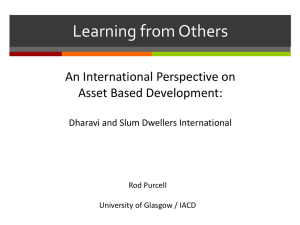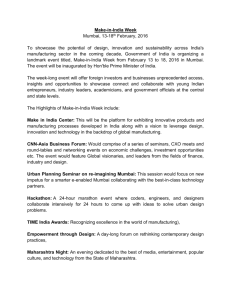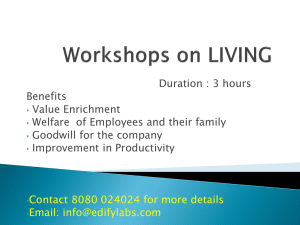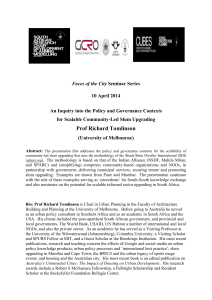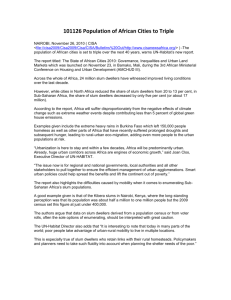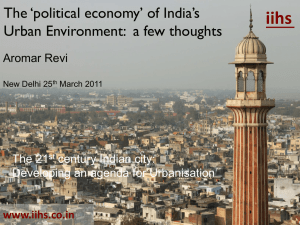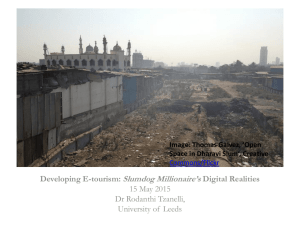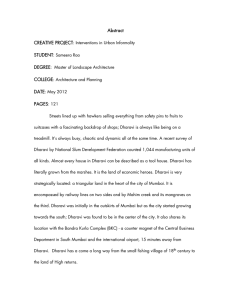Urbanisation in LEDCs - IBGeography
advertisement
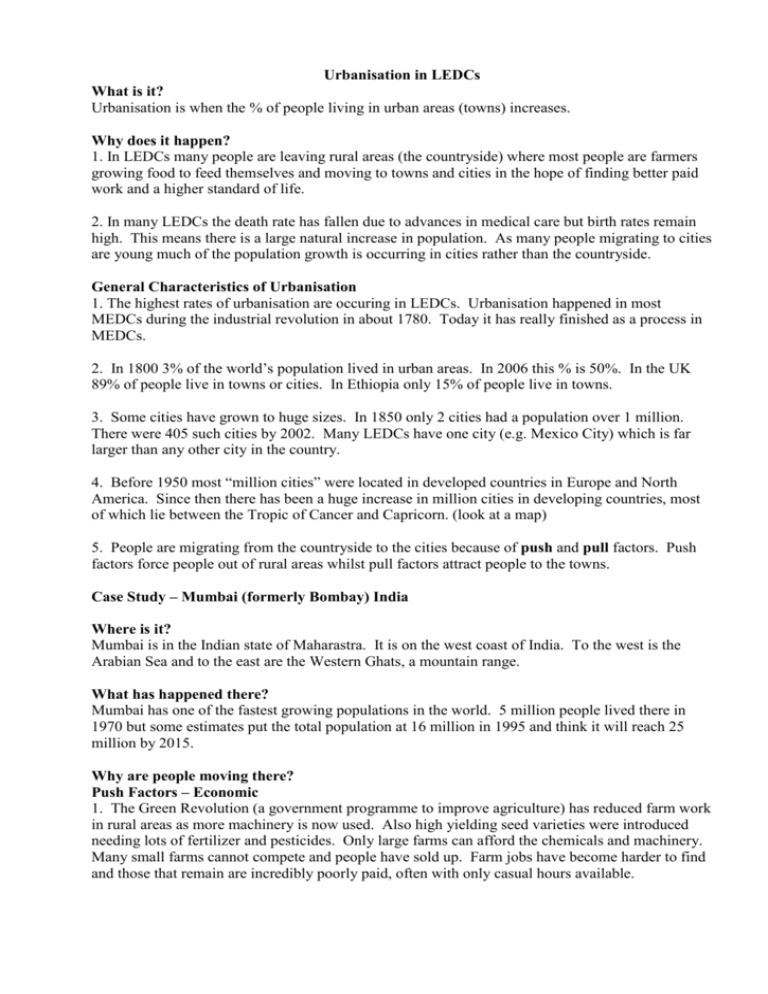
Urbanisation in LEDCs What is it? Urbanisation is when the % of people living in urban areas (towns) increases. Why does it happen? 1. In LEDCs many people are leaving rural areas (the countryside) where most people are farmers growing food to feed themselves and moving to towns and cities in the hope of finding better paid work and a higher standard of life. 2. In many LEDCs the death rate has fallen due to advances in medical care but birth rates remain high. This means there is a large natural increase in population. As many people migrating to cities are young much of the population growth is occurring in cities rather than the countryside. General Characteristics of Urbanisation 1. The highest rates of urbanisation are occuring in LEDCs. Urbanisation happened in most MEDCs during the industrial revolution in about 1780. Today it has really finished as a process in MEDCs. 2. In 1800 3% of the world’s population lived in urban areas. In 2006 this % is 50%. In the UK 89% of people live in towns or cities. In Ethiopia only 15% of people live in towns. 3. Some cities have grown to huge sizes. In 1850 only 2 cities had a population over 1 million. There were 405 such cities by 2002. Many LEDCs have one city (e.g. Mexico City) which is far larger than any other city in the country. 4. Before 1950 most “million cities” were located in developed countries in Europe and North America. Since then there has been a huge increase in million cities in developing countries, most of which lie between the Tropic of Cancer and Capricorn. (look at a map) 5. People are migrating from the countryside to the cities because of push and pull factors. Push factors force people out of rural areas whilst pull factors attract people to the towns. Case Study – Mumbai (formerly Bombay) India Where is it? Mumbai is in the Indian state of Maharastra. It is on the west coast of India. To the west is the Arabian Sea and to the east are the Western Ghats, a mountain range. What has happened there? Mumbai has one of the fastest growing populations in the world. 5 million people lived there in 1970 but some estimates put the total population at 16 million in 1995 and think it will reach 25 million by 2015. Why are people moving there? Push Factors – Economic 1. The Green Revolution (a government programme to improve agriculture) has reduced farm work in rural areas as more machinery is now used. Also high yielding seed varieties were introduced needing lots of fertilizer and pesticides. Only large farms can afford the chemicals and machinery. Many small farms cannot compete and people have sold up. Farm jobs have become harder to find and those that remain are incredibly poorly paid, often with only casual hours available. 2. Population growth in rural Maharastra has been rapid. In India the tradition is for a father’s land to be divided equally between his sons. This has led to people farming plots of land which are too small to support a family and malnutrition occurs. Incomes are very low and it is hard to clothe and house and feed more children. There is malnutrition and overcrowding. Due to the lack of land people have farmed land in unsuitable areas (e.g. too dry). Areas have suffered soil erosion and become useless for farming. Social Factors 1. Educational and health standards are much lower in rural areas because it is hard to get teachers and doctors to work in the impoverished countryside. They want to work in towns where living conditions are better. 2. Young people see farming as hard work with long hours and low pay. It provides few prospects of a better life in the future. Pull Factors – Economic 1. There are better job prospects in Mumbai. There are jobs in the traditional industries of textiles, the port and jobs brought by TNCs e.g. ICI. Mumbai is the financial capital of India and many Indian companies have their headquarters there. All these jobs offer higher pay than farm work. 2. Investment by the Mumbai Metropolitan Authority, the Indian government and international agencies e.g. the UN in public works e.g. improving water supplies offers the potential of employment in public services. Social Factors 1. Mumbai has some good schools and universities as well as decent hospitals and dentists. If you can access these services your quality of life will be higher than in the countryside. 2. In Mumbai your home is more likely to have piped water, electricity and sewage disposal. Again these make your living standards higher than in the countryside. 3. Many migrants will already know people who have left the countryside to go to the city. They hope that these contacts will help them to find work and housing etc. What is life like in Mumbai? Housing – The Elite The elite in Mumbai live in Bungalows in southern Mumbai close to the CBD. They have top jobs in business or in government and their incomes are very high. Land prices in Mumbai are as high as in MEDCs so these houses are incredibly expensive and often have sea views. They have homes which were properly designed and built, with gardens, sewage facilities, constant running water and large airy rooms. Such families will employ servants to carry out tasks around the home. Children will be educated to a high standard, often at private schools and are likely to enjoy a lifestyle similar to their parents. The Middle Classes The middle classes tend to live in flats. Some are modern apartments with all mod-cons and 2/3 bedrooms. The closer you are to the CBD the more expensive your flat. This is because people do not want to spend all day in traffic trying to get to work on Mumbai’s horribly congested roads, trains or buses. Such people are likely to be educated to degree level and work in offices in the CBD or factories within Mumbai. The Poor The poor can be separated into 2 groups. Those who have formal, but poorly paid jobs and those who cannot find permanent employment and have to work in the informal sector. In Mumbai some of those with poorly paid but formal jobs live in Chawls. These are 4-5 storey blocks of flats that were built to house textile workers in the 19th century. They are now overcrowded and in a very poor state but people cannot afford anything better so have to live here. Many people who have formal jobs still find their incomes are too low to find a proper flat and may live in a slum. The rest of the poor with informal jobs are forced to live in slum housing or even worse on pavements. Where do the poor live in Mumbai? 1. About 700,000 people in Mumbai sleep rough on pavements each night. Usually these are new migrants to the city who are still looking for work and a place to build a shack. Other people who sleep rough may be so poor that they have even been unable to afford a shack. 50 -60% of people in Mumbai live in slums 2. Many people who have been in the city a little longer will find some kind of work and a spot to build a shack. In Mumbai you see people who have built shacks on the pavement as this is the only land they could find. Inside these one roomed homes people cook, sleep and live daily lives often using gas stoves and oil lamps for light. They are built from scrap wood and metal which people have found. The roofs are often covered in cloth/rags (not great in the wet monsoon). 3. Certain areas of the city have seen slum settlements built up on them. In Mumbai these slums are called Zopadpattis. They are found in certain parts of the city: a) Near the CBD on any vacant land – Close to offices and other businesses where casual work may be found and informal work opportunities may be good e.g. plenty of waste paper to collect and recycle. b) Next to railway lines – There is always a thin strip of vacant land next to railway lines so people have taken advantage and built on it. c) Next to main roads – Many slum dwellers make and sell products from roadside stalls to passing cars and lorries. E.g. fruit or shoes or snack foods. c) Near factories or Mumbai’s ports – People are sometimes lucky enough to be given a day’s work in a factory or ports when they are needed and may hope to find a permanent position one day. The main problem is that so many people are looking for a job they are very hard to find. Also land near factories may be vacant due to air or land pollution. d) On land no-one else wants – Dharavi for example was built on swamp ground which was at the time seen as mosquito invested and undesirable. Flooding is a risk in the wet monsoon. Case Study – Dharavi – Living in a Slum Where is it? Dharavi is the largest slum in Asia, housing 600,000 people. It is found in Mumbai, between the two main railway lines leading out of the CBD on former swampy land. It is close to the CBD of Mumbai. Housing Houses in Dharavi are often built out of materials people have found such as wood and corrugated iron. Some people have lived in Dharavi for many years and have upgraded their homes and made them more permanent. They may have made houses from bricks and concrete. The housing was not built in a planned manner as the housing was mostly illegally constructed. The streets are very narrow as the houses and workshops have been built close together as space is short. Dharavi is a lively place. It is full of workshops where many small craft industries thrive. In some of the houses which may have just 2 rooms it would not be uncommon for 10 people to share. Housing is very overcrowded. Public Services As homes were not planned for by the city’s government many homes lack basic facilities. Most homes have no running water so people use taps on the street which do not always work. Many homes have been illegally rigged to the electricity supply but some have no electricity at all. Telephone lines are uncommon, most people do not have them. Open sewers are usual as there are no sewage mains. In heavy rains these can overflow leading to diseases like cholera. As few people have bathrooms people wash on the streets outside their houses or go to the river. There are few toilets for slum dwellers and those there are are often poorly maintained and so disgusting people don’t want to use them and go on waste land or in the open sewers. There are few schools or health facilities for the people as they are too poor to pay for them and the authorities did not plan these facilities. Jobs Many trades are practised in Dharavi. It makes many things that people living in the rest of Mumbai need. Common industries are the making of clay pots, blacksmiths, metal smelting and recycling, paper recycling, plastic recycling and snack food preparation. There are many, many others. Economics in Mumbai There are not enough jobs in Mumbai for all who want one. There is no unemployment benefit so everyone must work. There are 2 possibilities: 1. The Formal Economy – e.g. working in textiles, rubber or chemicals; 3 big industries in Mumbai These jobs are sought after because: a) work is guaranteed by a contract b) pay is regular and you know what you will earn c) Benefits like holiday pay, sick pay and pensions d) Taxed so government raises money for schools, roads, hospitals etc. You need skills and qualifications to get many formal jobs 2. Informal Economy – a) legal e.g. cleaner, rubbish sorter, cycle rickshaw driver b) illegal e.g. prostitution, theft These jobs have problems because: a) Work is irregular b) you never know how much money you will make c) You get no work benefits d) the work is often dangerous Because so many people want a job in the formal economy wage rates are kept very low Problems of working in the Informal Economy 1. Income is low so cannot afford to send children to school (may be needed to work) or afford decent housing. 2. Do not earn enough money to send any back to rural area which may have been original intention. 3. No pension or sick care so big problems when sick and when you get old. 4. Informal jobs are often low skilled e.g. paper sorting so no improvements are made in skill levels so chances of a better job stay limited 5. Informal workers pay no tax so Mumbai authorities have low tax revenues and a lack of money to improve services. Advantages of Informal Economy 1. Many low paid workers are attractive to firms needing lots of labour so many TNCs are locating in India. Other Problems of Urbanisation in Mumbai 1. Water There is not enough water to go around. Daily deficit in water supply – 552 million litres. Slum dwellers often cannot get water. Many are forced to use untreated water causing diseases like cholera 2. The sewage system cannot cope Open sewers are a major health hazard 3. Air pollution There are so many cars and factories in the massive city that air pollution is terrible 4. Rubbish is not dealt with In slums there is often no rubbish collection as not planned for + streets are too narrow for rubbish trucks. Waste gets thrown on railway lines, in drains, onto roads and onto open spaces creating filthy conditions. 5. Infrastructure close to Collapse 10 million journeys are made into the CBD each day. The roads and railways can hardly cope. Traffic congestion is a major problem. It is getting worse as more Indians get richer and buy cars. Not enough homes are being built to cope with the growing population. There isn’t enough water, electricity or phone lines for everyone who wants one. Waiting times for a phone line can be huge. How have authorities tried to cope with rapid urbanisation? 1. By creating jobs Industrial development, especially by TNCs, has been encouraged by: a) building new roads to ease congestion b) moving some industries and commerce (shops + markets) to the outskirts of town (New Bombai) to reduce land values and congestion in the CBD c) ensuring businesses gain rapid access to water and electricity and by improving the port facilities, roads and phone lines to make the right conditions for businesss. 2. Improving Housing a) Building new low cost homes (but never enough for all who want one) b) Supplying water, sewage, electric etc to slums but there is always too little money and new slums are growing all the times so this has limited effect. c) Some slums have been knocked down as they were illegally built. Sometimes residents are rehoused elsewhere but not always. 3. Education, Healthcare Many charities run schemes to give slum dwellers access to education and basic health care. Again not everyone can be helped as resources are limited. How can people help themselves? Case Study – Rochinha – Rio de Janerio - Self Help Schemes A Self help scheme is where local authorities help the squatter settlement residents to improve their homes. Grants, loans and materials are offered to help residents make temporary homes more permanent. Wooden shacks are therefore turned into brick and concrete structures, tanks are fitted to roofs to catch rainwater and an electricity supply is obtained. Case Study – Sanjay Ghandi Nagar – Site and Service Scheme A Site and Service Scheme is a more formal way of helping squatter settlement residents, where land is divided into plots and basic infrastructure is provided before residents start to build their own homes. Sanjay Ghandi Nagar used to be a slum located in the CBD of Mumbai. It grew up on wasteland during the construction of a new building and became a permanent slum illegally built on land owned by the city authorities. On several occasions the government demolished people’s houses but the residents had nowhere to go so they kept rebuilding on the land. A charity called Nivara Hakk thought it was wrong of the government to treat people like this and helped the residents negotiate with the government. Eventually an agreement was reached that the residents would be given time to save to contribute towards buying some new land to build permanent homes on. Eventually after much arguing the slum dwellers were given new land by the government in the suburbs of Mumbai. The slum dwellers built their own houses on the land with a range of materials depending on what they could afford. The government provided electricity and water pipes on the land but the electricity doesn’t always work and there is only water between 2 and 5 am so people get up early to collect water for the day ahead. The new community is much further away from the CBD which is bad as many have a long, expensive journey to work but at least the slum dwellers know they legally own the land their homes are built on and the government didn’t have to spend much money helping the people as they did all the hard work themselves given the opportunity. Case Study – Dharavi – Local Authority Scheme – (Reurbanisation) In Dharavi the Mumbai Mteropolitan Authority has ambitious plans to turn Dharavi into a world class suburb of offices, homes and leisure facilities. They are embarrassed that such a massive slum should exist in the heart of the city and that it creates a bad impression on visitors to the city. Mumbai is the business capital of India and there is a shortage of space for quality retail and office developments as India’s economy is booming. They asked interested private companies to submit bids for the land on which Dharavi sits along with detailed plans as to how they would redevelop the slum area. Developers had to come up with plans that would help the current slum dwellers as well as make the developers profits. Mukesh Mehta was in charge of one successful tender. He intends to rehouse slum dwellers in apartments in blocks of flats. Each apartment will have a toilet and bathroom and all facilities will be connected e.g. electricity. Only slum dwellers who can prove they lived in Dharavi prior to 1995 are eligible for a new flat. On the new land available office space, retail malls, golf courses and even a cricket stadium are planned. These will make a lot of profit for the developers and some of this profit is being used to build the houses for the slum dwellers. However there is huge dissatisfaction with the scheme amongst slum dwellers. Firstly there is no provision for people who have made Dharavi their home in the last 5 years so they will have to go and squat somewhere new. Also the homes may be fine to live in but the residents of Dharavi also use their homes as workshops producing goods sold right across the city. Many people will be unable to continue to trade if they are stuck on the seventh floor of an apartment block. They will also be liable to pay all taxes and charges incurred on their homes and they are unlikely to be able to afford these. Therefore people allocated new homes may be forced out of the flats as they will not be able to afford to live there. Slowly the whole area will be taken over by big business and richer residents and slum dwellers will be driven into other slums elsewhere. Attitudes towards Urbanisation In rural areas 1. Old people don’t like urbanisation as they get left behind in the rural villages. They worry about who will farm the land and look after them when they are too old to work. 2. Commercial farmers who have benefited from the green revolution like urbanisation as they make more money by selling their produce if more people start to live in towns and cities. 3. Some people like farmers like urbanisation as it takes pressure off the land which was being overfarmed and damaged due to increasing population pressure in the countryside. In urban areas 1. Business people like urbanisation as it keeps wage rates low and means that they can remain very competitive and make large profits. 2. The city authorities don’t like urbanisation because they cannot keep up providing the infrastructure, housing and other facilities demanded by the rapidly growing population. They think the slum dwellers make the city look a mess and in places like Dharavi they want the land to expand the CBD but the slum gets in their way. 3. Some home owners who find themselves living near slum dwellers don’t like urbanisation as they think the slum dwellers are dirty and the slums are dangerous places that they don’t want near them. 4. In some ways the city authorities like urbanisation as it helps businesses in Mumbai develop. They also realise that the migrants play a crucial role in keeping the city going by recycling masses of materials used in the city and in meeting the needs of other city dwellers by cooking much of the cities food, making many of the products sold in the city and not least washing many of the residents clothes in the city’s laundry facility.
